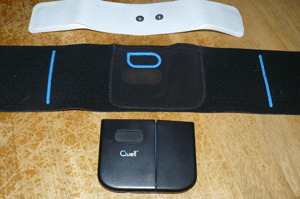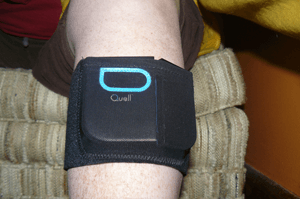by Micke Brown & Teresa Shaffer
 Last August 2014, I wrote, The TENS Effect, which was about the use of TENS units as it seemed like TPC members and online viewers had questions about what it is, how it worked and how it can be versatile to help disrupt the pain messages as they attempt to travel through the nervous system. The take home message was, “interrupting pain signals can be an effective way of minimizing pain intensity for some of us.”
Last August 2014, I wrote, The TENS Effect, which was about the use of TENS units as it seemed like TPC members and online viewers had questions about what it is, how it worked and how it can be versatile to help disrupt the pain messages as they attempt to travel through the nervous system. The take home message was, “interrupting pain signals can be an effective way of minimizing pain intensity for some of us.”
Little did I know that this spring of 2015, Teresa and I would be invited to test out a new, “TENS-like” nerve stimulation device called Quell. In the spirit of sharing What’s New in pain relief options, we thought you would like to hear about this option and our experience. I believe it illustrates how pain relief differs from person to person, no matter the option used and no matter in what combination. Each of us who lives with pain has different responses, the contents in our pain toolbox looks different and we use our treatment options in different ways—multi-modality, individualized and “patient-centered.” So we are saying from the onset, that this device may work great for some, fair for some and not at all for others.
First of all, let me explain the device. It is manufactured by NeuroMetrix. Quell is a medication free, pain relief device. According to their website, “Quell intensive nerve stimulation (WINS) technology has proven to fight pain; it is FDA approved for the treatment of chronic neuropathic pain due to painful diabetic neuropathy, sciatica, fibromyalgia, and osteoarthritis among other conditions during the day or night.“
It is has a rechargeable battery and a companion phone app that helps it run and monitor your treatment cycles, tracks your sleep duration, tells you when to take it off and allow your skin to breath as well as reminds you when the lead pads should be changed. It is portable, as the light weight device tucks into the pocket of a Velcro strap that you wear just below your knee and snaps into the lead pads. Once you set it up to meet your desired sensation, you only need to turn it on after it is applied and the phone app does the rest. If you need to increase or decrease the sensation, it is easy to adjust.
Teresa’s Experience:
 Years ago, I was prescribed a TENS unit to use for lower back pain. I used it off and on for years but never really felt like I was getting the relief I thought I should. Fast forward several years later and I was talking to Micke about TENS units. She asked if anyone ever showed me how to place the leads to get maximum relief and my answer was no. I really had not given it much thought before then–no one ever showed me how to use it. After we talked, it made perfect sense that I may not have even been using it right. So my best advice to everyone, if you get a TENS unit or have one now, make sure you ask for instruction from someone who knows about the best lead placement and how to adjust the stimulation to suit your needs.
Years ago, I was prescribed a TENS unit to use for lower back pain. I used it off and on for years but never really felt like I was getting the relief I thought I should. Fast forward several years later and I was talking to Micke about TENS units. She asked if anyone ever showed me how to place the leads to get maximum relief and my answer was no. I really had not given it much thought before then–no one ever showed me how to use it. After we talked, it made perfect sense that I may not have even been using it right. So my best advice to everyone, if you get a TENS unit or have one now, make sure you ask for instruction from someone who knows about the best lead placement and how to adjust the stimulation to suit your needs.
Now on to the Quell, when I was first approached and invited to test Quell, I have to say I was a little skeptical. I went onto their website and read all about it; it sounded like a different version of a TENS unit to me. However, we should always, always keep an open mind to all treatments that are available and new ones that come along.
I have rheumatoid arthritis and degenerative joint disease, so my poor joints don’t stand a chance. My toolbox contains:
- Resting on heating pads off and on through the day as needed
- Wearing one kind of shoe that give me the best support (for me, it’s a style made by Skechers)
- Performing household chores and other strenuous activities in small doses: no more than 15-20 minutes before taking a break
- Taking my pain medications exactly as my healthcare provider had prescribed them
- Remaining positive
- Using distraction to help me manage the pain each day.
So, the potential of adding a new relief option to my toolbox was not turned away. When the Quell arrived in the mail, I was having a huge pain flair in my left knee. I read the instructions and was very pleased how easy it was to setup and use. I wore the Quell all day and I found the gentle currents to be a nice distraction from the pain. It was definitely NOT like the TENS unit. There was no messy gunk to place on the leads; there were no cords to mess with or get in the way. I did not have to worry about readjusting the stimulation and I did not have any sudden, unpleasant spikes of electrical shock like what happened to me when I wore a TENS unit.
The pain flair in my knee was extremely long this time and so I wore the Quell each day for 2 weeks. I have not worn it at night yet because I need the pain relief more through the day so I can function. I found it so easy to put on and take off. No mess, no fuss and pain relief too: it doesn’t get much better than that. It definitely worked for me and I am grateful. The only thing negative I can find is that I wish Quell was covered by my insurance for the actual device and/or for the replacement leads.
Micke’s Experience: As I have foot, ankle and low back pain due to arthritis and sciatica, I was immediately interested in seeing how it might work for me, so that I could stop limping at the end of the day after walking the dogs, mowing the lawn, cleaning the house or gardening. Though I appreciate having a more personal pain experience in solidarity with the rest of you who live with pain every day, I did not want to be slowed down, not yet, at least. Over-the-counter medication helped somewhat, however, I wanted to be careful and avoid daily dosing if at all possible. I am a pain management nurse and well versed in the pitfalls of NSAIDs. My pain toolbox contained the following:
- Alternating heat during the day or evening and ice at night
- Wearing insole supports in my shoes
- Wearing a pair of high quality walking shoes when I walk the dogs,
- Resuming yoga stretching in the morning and while in a hot shower
- Pacing my activities
- NSAID dose each day or every other day.
My pain levels were not approaching severe, so I was not ready to cry uncle and seek out more expert help.
The result of adding Quell to my pain toolbox was surprising. It eased my pain to the mild ranges and not only did I stop limping after activities, but I was able to reduce my NSAID dosing to once or twice a week. I continue to ice my back at night, yet not every night. I have found that I do not have to wear it every day and not all day as in the beginning. I do try to pre-empt pain, so I will have it on when I mow the lawn, walk the dogs or know that I will be on my feet for extended periods of time. I have worn it at night, out of curiosity, since I tend to have less pain while sleeping. It is cool that I can see that I sleep 94-96% of the night—pretty good track record for a gal in menopause!
Interesting, right? In case you were wondering, Quell does not require a prescription, however, your healthcare provider should know about its use or you should ask about it ahead of time. When I shared it with my PCP, she was fascinated as she is a fan of TENS units.
Like any pain treatment option, Quell is not the magic bullet. What works for one person, may not work for another. It is just refreshing to learn about what else is out there for pain relief options. As I have taught other nurses for quite a while now, “learn about all the different ingredients that are out there, to help your patient build the recipe that works best for them.” Quell is a new ingredient to consider.

It is great to hear about new pain treatments to add to my pain toolbox.